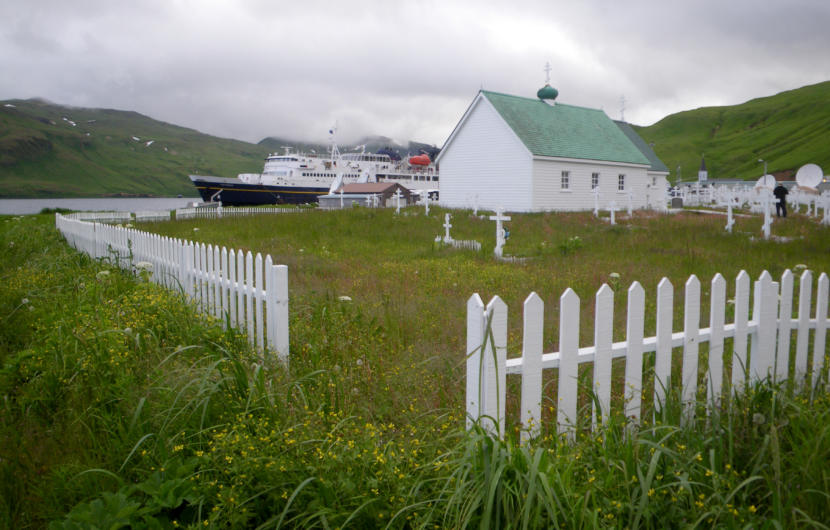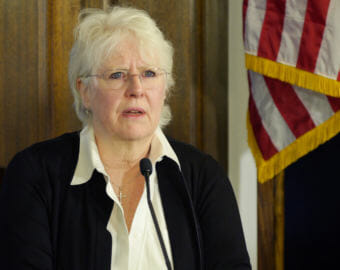
The group tasked with reshaping the future of the state-run ferry system is recommending the creation of an executive board, fewer vessels, and at least two years of forward funding for the cash-strapped ferries. The Alaska Marine Highway Reshaping Work Group wrapped up eight months of work this month and has forwarded its ideas to the governor’s office.
The report has not yet been released to the public.
Tom Barrett, a retired Coast Guard admiral and pipelines services executive, chaired the group’s 30-odd videoconference meetings. At its final one on September 30, he said that the group’s recommendations should be taken as independent advice.
“I’ve got no direction steering or limits suggested by anybody in the administration,” Barrett told members of the nine-person panel. “So it’s our report. People can like it or dislike it. Adopt recommendations or not, some of the changes we’re recommending are hard, and will require a fair amount of work to actually make happen.”
Gov. Mike Dunleavy created the task force to evaluate the $250,000 ferry study prepared by Northern Economics last year. It did that and more, including endorsing the creation of a Marine Highway executive board to steer operations and long-term planning.
That would replace the existing Marine Transportation Advisory Board which had originally been created for that role. It was downgraded to an advisory body by Gov. Sarah Palin in 2008.
Fewer vessels running and in layup
The work group also recommends reducing the size of the fleet. Barrett pointed to laid up vessels including the two fast ferries and the Malaspina, which are moored at the private Ward Cove at public expense.
“They cost $170,000 a month to keep at the dock,” he said of the idle ships, “and they’re never coming back in the system. And literally, you may have to give them away.”
The group didn’t reach consensus on every issue. Some wanted language endorsing progress on replacing the Tustumena, a federally funded project on hold until 2023.

Tony Johansen, a road contractor from Fairbanks, maintains that it’s too expensive. He recommended scrapping service to Southwestern Alaska where airplanes can take people and barges can carry freight.
“But surely don’t build a huge vessel,” Johansen said, “that’s going to cost a fortune to run with for a system that’s on its deathbed — unless it gets more money out of out of the state system.”
That raised the hackles of Kodiak Republican Rep. Louise Stutes.

“My blood is boiling here,” she interjected. “Because to just arbitrarily tell a good portion of coastal Alaska: ‘Well, sorry, folks, you’re done.’ It just rubs me the wrong way. It is treating Alaskans poorly.”
It’s unclear whether the Tustumena replacement project was addressed in the work group’s final draft.
More roads, reduced labor costs
Drafts circulated also recommend fewer sailings across the system, fewer communities served, ways to increase road access to coastal communities and to find ways to reduce personnel costs.
Representing the marine highway’s ferry workers was Ben Goldrich of the marine engineers union. He pushed back on wages being a target for cuts. He suggested more effort to cut waste in procurement, repairs and maintenance from outsourcing by letting ferry crews do more routine maintenance and service work.
“Ten or 15 years ago, there seemed to be a concerted effort to move away from the crews and move towards vendors and the shipyard,” Goldrich said. “Every time a part is ordered, somebody is trying to get a piece of the action. And that is a place where they can reduce costs by involving the crews more.”
Other recommendations included asking the Legislature to provide forward funding for at least two years, allowing the marine highway to plan and create schedules 12 to 18 months in advance.
Transportation agency to craft ‘implementation plan’
Department of Transportation spokesperson Andy Mills confirmed that the document has arrived in the governor’s office, but said it won’t be publicly released until agency staff has a chance to digest it and prepare its own implementation plans in the next two weeks.
“It’s our plan to have those discussions, and to have at least the initial outline of what recommendations we can act upon in the near and then maybe the long term, have that sketched out as well,” Mills told CoastAlaska on Friday.
A majority of the work group looked favorably on a controversial new ferry terminal at Juneau’s Cascade Point. Proponents say it would shave two hours of travel time on runs up Lynn Canal, allowing dayboats to complete the round trip voyage between Juneau, Haines and Skagway within a 12-hour window.
The work group also recommends the agency adopt a long term plan for the ferry system. And to create a three-member transition team to work within the agency to implement changes in the near future.